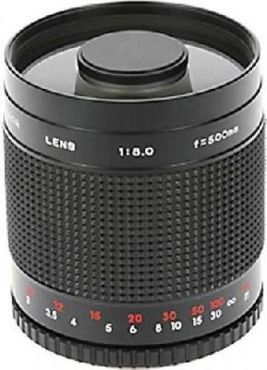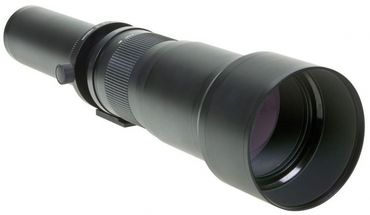Danubia Lenses - What you should know before buying
A good SLR or system camera is only half the battle when it comes to taking stunning and unique photos. Different lenses are also a must in order to adapt to different uses and have the right equipment ready for every photo. For example, portraits with a blurred background require a fast lens with a wide-open aperture, while telephoto lenses are necessary to capture distant subjects in rich detail.
Lenses are not only offered by the manufacturers themselves for the popular SLR and system cameras, but also by third-party manufacturers. You can therefore equip your Canon DSLR not only with Canon lenses, but also with lenses from Sigma or Tamron, for example. A not so well-known manufacturer of lenses is Dörr Danubia. Unjustly so, we think! This company produces lenses for both system and SLR cameras that are characterised by high imaging performance. At the same time, the lenses of this manufacturer convince with their robust and qualitative workmanship, which ensures a good feel and easy handling. Due to the good imaging performance, the images that can be achieved with the lenses are very detailed and sharp.
The range of lenses from Danubia is extensive, so that the needs of every photographer are served. There are wide-angle lenses for landscape photographers, telephoto lenses for wildlife or sports photography, and lenses for special applications such as fisheye lenses. Of course, just like other modern lenses, Danubia lenses have practical functions such as a fast autofocus and an image stabiliser, so that no wishes remain unfulfilled.
If you are unsure what kind of lens you need, you should first consider what you want to use it for. The intended use will determine which focal length you should choose. For example, a wide-angle lens is more suitable for landscape photography, while a longer fixed focal length should be used for high-quality portraits. To bring distant subjects close to the viewer, you cannot avoid a telephoto lens.
Even if it is to be a lens from a third-party manufacturer such as Danubia, it is also important that you choose the right bayonet that fits the mount of your camera. It differs from supplier to supplier, so it is not possible to connect a lens with a Nikon bayonet to a Canon camera or vice versa. Furthermore, it is important whether you have a full-frame camera. If this is the case, you cannot use lenses with a crop sensor, but must choose a version that is intended for full-frame cameras. On crop cameras, on the other hand, you can use both lenses for full-frame cameras and optics for cameras with crop sensors.
Popular Danubia lenses presented
To make it easier for you to choose a Danubia lens, we present some popular models in a little more detail below.
The Dörr Danubia 420 to 800 millimetre f/8.3 with T2 mount
The telephoto zoom 8.3/420-800mm T2 is quite simply constructed. Compared to the much more expensive telephoto lenses from Tamron, Canon, Sigma and Nikon, it is not an alternative, but it does not pursue this claim either. Instead, the comparatively inexpensive telephoto zoom is interesting for leisure and hobby photographers who only need a telephoto lens now and then. The T2 mount ensures that the lens is compatible with almost every SLR or system camera currently available on the market. However, you still need an optionally available T2 adapter for this. The focal length of 420 to 800 millimetres allows you to capture subjects that are far away on the sensor. However, the lens does not have autofocus, so you need a good eye. You adjust the focal length by pulling the barrel in or out, while you set the aperture via a ring directly on the lens. It varies between 8.3 and 16, which means that you need a lot of light, which is why the lens is ideal for outdoor photos. In addition, a stable tripod is definitely an advantage to take photos without blurring. This lens can be used on both full-frame and APS-C sensor cameras.
The Danubia Mirror Telephoto 8.0/900 T2 and the 500mm Mirror Telephoto with an aperture of 6.3
This telephoto lens, which has a focal length of 900 millimetres, is also very compact. The speed is 8.0 throughout and here, too, there is a T2 universal mount. In addition, the Danubia mirror telephoto 8.0/900 T2 is characterised by a multi-coating. Mirror lens means that the image is not projected onto the sensor with lenses, but with the help of a mirror system. This also makes the particularly compact and short design possible. Points of light that are out of focus are shown as circles. This offers many creative possibilities, especially for portraits. However, stopping down is not possible with mirror lenses.
The 500mm mirror telephoto lens from Danubia is constructed in a very similar way. It has a constant speed of 6.3 and a focal length of 500 millimetres. The mirrors used have a high reflectivity and can therefore guarantee a high light intensity. The lens offers ten times the magnification of the human naked eye. This lens from Danubia is also distinguished by the fact that it is very inexpensive compared to popular telephoto lenses from other manufacturers, which is why it is a good choice for beginners and amateur photographers in particular.
The Danubia Fisheye 8mm 1:3.5
If you want to deviate from the mainstream of photographers, try something new and depict the world in unusual perspectives, you are well advised to go for the Danubia Fisheye 8mm 1:3.5. This fisheye lens, which has a maximum speed of 3.5 and a focal length of 8 millimetres, is characterised by a very large angle of view with an enormous range of sharpness. A fisheye lens is nothing more than an extreme wide-angle lens that creates strong distortions in the image because it bends straight lines that do not run exactly through the centre of the image. So you can shoot a subject from an extremely short distance and still have a lot of the surroundings in the picture. However, all elements that are not in the centre are shown comparatively small. The typical distortion of fisheye lenses can be used in a creative way. This lens is particularly suitable for reportage, architecture and landscape photography. But in principle it can be used in all areas of photography to give your shots that certain something.



Simply subscribe and benefit as a newsletter recipient every week: